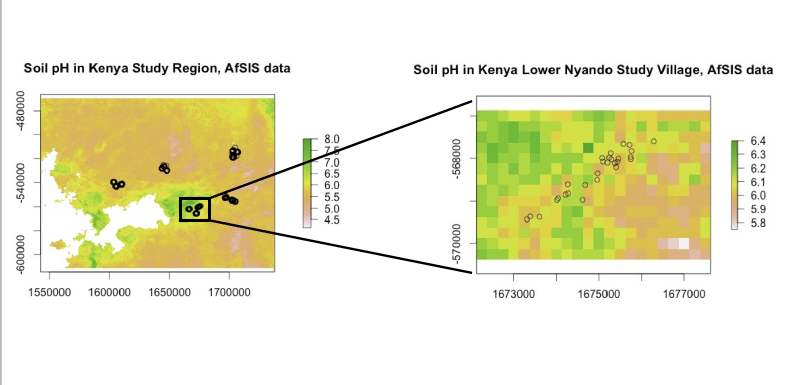To bring attention to the important role that soils play in agricultural and human development, the United Nations declared 2015 the International Year of Soils. Inspired by this declaration, Julia Berazneva and Leah Bevis emphasized the importance of soils to development economists via a series of posts here at ETRM. Despite the growing realization of the importance of soil fertility in agricultural development, major barriers remain in our understanding of how farmers form perceptions about their soil fertility, and how soil fertility—whether farmer reported, directly measured, and/or spatially estimated—is related to farmers’ behaviors in terms of their input use, cropping strategies, and other management practices.
For this reason, in collaboration with David Guerena, we posed and answered the following research questions in a recent working paper that we’ll be presenting at the upcoming 2016 Midwest International Economic Development Conference:
- What can we learn from household survey data about how farmers in east Africa form perceptions about their soil fertility? Do agricultural inputs and/or outputs vary with perceived soil quality and soil type?
- How well do farmers’ subjective perceptions of soil fertility correspond to objective laboratory measurements of soil chemistry? Are there any systematic factors affecting farmers’ soil fertility perceptions?
- Can high-resolution and publicly available estimated spatial soil fertility data provide sufficient information to obviate the expensive and time-consuming collection of detailed plot-level data?
- What is the value of soil information? Are there significant costs to farmers’ and researchers’ (mis)perceptions about local soil fertility?
In answering these questions, we rely on three data sets that correspond with a small number of maize farming households in western Kenya and two data sets that correspond with a nationally representative sample of maize farmers in Tanzania. In both study regions, farmers’ perceptions of soil fertility and their agricultural practices are drawn from household survey responses. GPS coordinates allow us to match all of these households with publicly available geo-referenced soil data at 250-meter spatial resolution from the Africa Soil Information Service (AfSIS). In western Kenya, we also have available laboratory measures of plot-level soil fertility obtained from soil samples.

Using these data to address each of our research questions, we come to several conclusions:
Questions 1 and 2. Using difference in means tests, we find that farmer perceptions of soil fertility are more correlated with maize yields than with agricultural inputs. Farmers appear to rely on yields as the main indicator of soil fertility, a finding also observed by Marenya, Barrett and Gulick (2008) in Kenya and Karltun et al. (2013) in Ethiopia. The direction of the soil fertility and yield relationship cannot, however, be determined from our data. Therefore, absent more information or an exogenous instrument, we urge caution when including farmers’ perceptions of soil quality in the estimation of yields.
In Kenya, farmers’ reported soil type (clay, loam, or sandy) is a reasonable predictor of several objective soil fertility indicators drawn from mid-infrared spectroscopy soil analysis while farmer-reported soil quality is not. An ordered probit analysis suggests no clear pattern between farmers’ perceptions and observed plot and household characteristics, such as might inform targeted information treatment efforts.
Question 3. Although the AfSIS data track the locally collected soil analysis data in Kenya (Figure 2), there are statistically sufficient differences between the two data sets to merit collection of soil samples for the purpose of household and village-level analysis. These differences are especially pronounced for soil organic carbon and total nitrogen content, two measures of soil fertility that are very susceptible to management practices.

Question 4. Finally, we estimate a maize production function with and without soil variables to assess the value of soil information in such an analysis. Although coefficients on soil variables are almost always statistically significant, in neither Kenya nor Tanzania does including soil information of any type change the mean of predicted yields or the marginal physical productivity of fertilizer. This is a surprising finding; however, the caveats to our analysis are considerable. For example, we observe low empirical variation in soil variables in both data sets and are unable to control for unobserved household or plot-level heterogeneity that might bias our estimates.
Our analysis also only considers cross-sectional evidence and describes statistical associations. We still have a lot to learn about how farmers make judgments about their soil fertility and whether soil fertility information alters farmer behaviors in terms of inputs and cropping decisions. Experimental or quasi-experimental studies could help identify the causal linkages among farmers’ perceptions, their management practices, and actual soil fertility, allowing researchers to take a step towards better understanding soil and human welfare dynamics.

